History
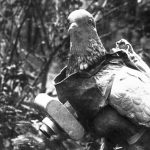 When we think of war, we think mostly of battle, but we should also think of the spies that gather intel. Most often, spies are men and women who have been carefully trained to avoid the enemy, and very possibly to live among the enemy without being detected, so they can hear the plans of the enemy and pass the information to the intelligence community, so it can be used against the enemy so as to win the war. There is, however, another kind of spy that has long been used in war, and was used especially during World War I and World War II…the pigeon. Now this is a spy I would have never have imagined.
When we think of war, we think mostly of battle, but we should also think of the spies that gather intel. Most often, spies are men and women who have been carefully trained to avoid the enemy, and very possibly to live among the enemy without being detected, so they can hear the plans of the enemy and pass the information to the intelligence community, so it can be used against the enemy so as to win the war. There is, however, another kind of spy that has long been used in war, and was used especially during World War I and World War II…the pigeon. Now this is a spy I would have never have imagined.
The reason pigeons caught the attention of the military was that they were trained to fly home…from wherever they were dropped off. I have no idea how they can do that, but they can and do. The spy pigeons went in as Operation Columba, during some of the bloodiest years of World War II. The idea was to drop cages attached to parachutes into the occupied areas of France, with the hope that the people and resistance members, as well as soldiers could attach messages with critical intel on the enemy locations to the pigeons, who would then be sent back to their home base. There, soldiers would be 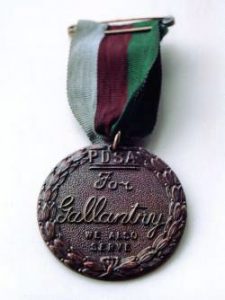 waiting to get the messages to the intelligence community. The plan was perfect, but very risky for the pigeons. So many dangers awaited them…the guns of the enemy, not being found and dying in the cage, and one most of us wouldn’t think of…hungry people. The operation, on its face, was deceptively simple. The British planes dropped 16,000 homing pigeons over occupied Europe during the course of the war, parachuted in small baskets with rice paper, containing a list of questions to be answered by civilians who found them, tucked into canisters tied to their legs. Then the pigeons were to be sent home. Many were lost to the perils in their way, but there were a good number who made it back. A some were decorated with the Dickin Medal for their service…32 pigeons in all were awarded the medal. Pigeon Soldiers like “Winkie” (1943), “Commando” (1944), “Paddy” (1944), “William of Orange” (1944), Mary of Exeter (1945), “G.I. Joe” (1946), Gustav (1944), and Beach Comber (1944), just to name a few. The homing pigeons were donated by their owners…no small sacrifice when you consider that so many lost their lives during the operation. Still, like their human counterparts, the pigeons did their duty, and made their owners proud.
waiting to get the messages to the intelligence community. The plan was perfect, but very risky for the pigeons. So many dangers awaited them…the guns of the enemy, not being found and dying in the cage, and one most of us wouldn’t think of…hungry people. The operation, on its face, was deceptively simple. The British planes dropped 16,000 homing pigeons over occupied Europe during the course of the war, parachuted in small baskets with rice paper, containing a list of questions to be answered by civilians who found them, tucked into canisters tied to their legs. Then the pigeons were to be sent home. Many were lost to the perils in their way, but there were a good number who made it back. A some were decorated with the Dickin Medal for their service…32 pigeons in all were awarded the medal. Pigeon Soldiers like “Winkie” (1943), “Commando” (1944), “Paddy” (1944), “William of Orange” (1944), Mary of Exeter (1945), “G.I. Joe” (1946), Gustav (1944), and Beach Comber (1944), just to name a few. The homing pigeons were donated by their owners…no small sacrifice when you consider that so many lost their lives during the operation. Still, like their human counterparts, the pigeons did their duty, and made their owners proud.
The pigeons did other work, besides just delivering messages. The military equipped some with tiny cameras and they pigeons took reconnaissance photos as they flew back to their home base. The military didn’t have drones in those days, and planes flying “low and slow” would surly be shot down, so the pigeons served as 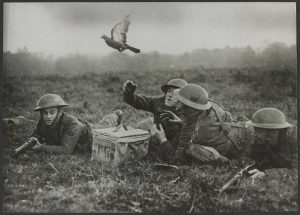 drones in their day too. Most of us think of homing pigeons as being a hobby, and I suppose it started out as that for most of the handlers, but then they grew to love their pigeons…just like family. Each loss was felt deeply, and each successful return met with great relief. They were proud of their very special soldiers, and we as a nation should be too. It gives me a whole new view of pigeons, which I have always enjoyed watching whenever I am in downtown Casper, where we have a beautiful flock of them that grace the skies above town…dipping and soaring high above the buildings, as if in play, but we should remember that at any time, they could be called upon to serve in a different capacity, if the need arose.
drones in their day too. Most of us think of homing pigeons as being a hobby, and I suppose it started out as that for most of the handlers, but then they grew to love their pigeons…just like family. Each loss was felt deeply, and each successful return met with great relief. They were proud of their very special soldiers, and we as a nation should be too. It gives me a whole new view of pigeons, which I have always enjoyed watching whenever I am in downtown Casper, where we have a beautiful flock of them that grace the skies above town…dipping and soaring high above the buildings, as if in play, but we should remember that at any time, they could be called upon to serve in a different capacity, if the need arose.
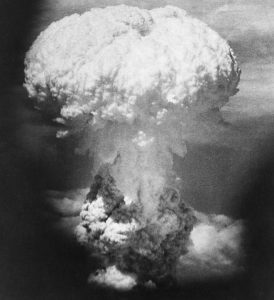 When the first atomic bomb exploded over Hiroshima on August 6, 1945, the city was instantly in ruins. The bomb immediately ended the lives of 80,000 of the 350,000 people of Hiroshima.
When the first atomic bomb exploded over Hiroshima on August 6, 1945, the city was instantly in ruins. The bomb immediately ended the lives of 80,000 of the 350,000 people of Hiroshima.
Tsutomu Yamaguchi was born on March 16, 1916 in Nagasaki, Japan, where he grew up and in the 1930s, joined Mitsubishi Heavy Industries working as a draftsman designing oil tankers. Then in the summer of 1945, he was in Hiroshima for a three-month-long business trip. That trip was at its conclusion on August 6th, and he was preparing to leave the city with two colleagues, Akira Iwanaga and Kuniyoshi Sato. They were on their way to the train station when Yamaguchi realized he had forgotten his hanko (a type of identification stamp common in Japan) and returned to his workplace to get it. That one act would have monumental consequences.
At 8:15am, Yamaguchi was walking towards the docks when the American B-29 bomber Enola Gay dropped the Little Boy atomic bomb near the center of the city, only 1.9 miles away. Yamaguchi recalls seeing the bomber and two small parachutes, before there was “a great flash in the sky, and I was blown over”. The explosion 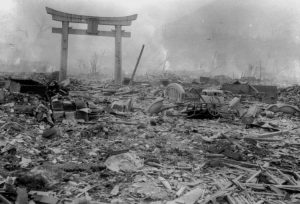 ruptured his eardrums, blinded him temporarily, and left him with serious radiation burns over the left side of the top half of his body. After recovering, he crawled to a shelter and, having rested, he set out to find his colleagues. They had also survived and together they spent the night in an air-raid shelter before returning to Nagasaki the following day. In Nagasaki, he received treatment for his wounds and, despite being heavily bandaged, he reported for work on August 9th. As soon as he could get out, Yamaguchi went back home to Nagasaki.
ruptured his eardrums, blinded him temporarily, and left him with serious radiation burns over the left side of the top half of his body. After recovering, he crawled to a shelter and, having rested, he set out to find his colleagues. They had also survived and together they spent the night in an air-raid shelter before returning to Nagasaki the following day. In Nagasaki, he received treatment for his wounds and, despite being heavily bandaged, he reported for work on August 9th. As soon as he could get out, Yamaguchi went back home to Nagasaki.
Ironically, Yamaguchi arrived in Nagasaki on August 9, 1945. Back at his office, Yamaguchi was describing the blast in Hiroshima to his supervisor at 11:00am, when the American bomber Bockscar dropped the Fat Man atomic bomb over the city. Yamaguchi’s workplace again put him 1.9 miles from ground zero. This time he was unhurt by the explosion, however, he was unable to replace his now ruined bandages and he suffered from a high fever and continuous vomiting for over a week. I’m sure he felt like he was dying. Technically, some 100 people were known to have been 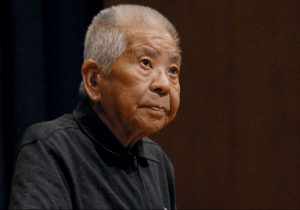 affected by both bombings. In 1957, Yamaguchi was recognized as a hibakusha “explosion-affected person” of the Nagasaki bombing. It is unknown, why the government didn’t recognize the other survivors. In 2006 Yamaguchi addressed the United Nations General Assembly in New York City in support of nuclear disarmament. It was not until March 24, 2009, that the government of Japan officially recognized his presence in Hiroshima three days earlier, as well. He died of stomach cancer on January 4, 2010, at the age of 93. Yamaguchi was the only “officially” documented survivor of both the August 6, 1945 Hiroshima and the August 9, 1945 Nagasaki atomic bombings during World War II.
affected by both bombings. In 1957, Yamaguchi was recognized as a hibakusha “explosion-affected person” of the Nagasaki bombing. It is unknown, why the government didn’t recognize the other survivors. In 2006 Yamaguchi addressed the United Nations General Assembly in New York City in support of nuclear disarmament. It was not until March 24, 2009, that the government of Japan officially recognized his presence in Hiroshima three days earlier, as well. He died of stomach cancer on January 4, 2010, at the age of 93. Yamaguchi was the only “officially” documented survivor of both the August 6, 1945 Hiroshima and the August 9, 1945 Nagasaki atomic bombings during World War II.
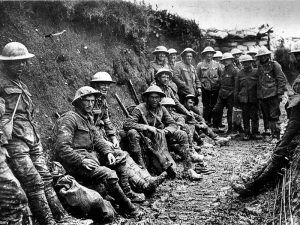 World War I brought a new kind of fighting…trench warfare. It actually started on September 15, 1914, when a battle dragged on far longer that anyone ever expected. The Battle of the Marne was expected to be over quickly, but the soldiers had other ideas. Allied troops halted the steady German push through Belgium and France that had proceeded over the first month of World War I, but neither side was willing to give up. Allied and German forces begin digging the first trenches on the Western Front. They were in this for the long haul. It was the beginning of trench warfare…a tactic that went on until 1918.
World War I brought a new kind of fighting…trench warfare. It actually started on September 15, 1914, when a battle dragged on far longer that anyone ever expected. The Battle of the Marne was expected to be over quickly, but the soldiers had other ideas. Allied troops halted the steady German push through Belgium and France that had proceeded over the first month of World War I, but neither side was willing to give up. Allied and German forces begin digging the first trenches on the Western Front. They were in this for the long haul. It was the beginning of trench warfare…a tactic that went on until 1918.
Trench warfare was a good tactic to use for the most part, because it provided some protection from the enemy forces on the ground. The air war during World War I was much different that the air war of World War II. There were no heavy bombers, and while 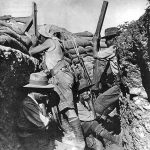 there were fighter planes, most of the war was fought on the ground…in the trenches. Soldier had some place to hide from the bullets that were flying by them at lightning speed. The men often used periscopes to safely see over the sides of the trenches. There is no completely safe way to fight hand to hand combat, but the trenches were often the best protection available. Still, while the trenches did provide a measure of protection, they had their dangers too. First, the trenches had to be dug, and the digging might easily be done with the enemy coming up on you fast, or worse yet, already there. The trenches were dug by the men, in ground that was often hard and rocky, but the job had to be done, and then the battle still had to be fought, no matter how weary the soldiers were…no matter how much they needed sleep, in a warm bed.
there were fighter planes, most of the war was fought on the ground…in the trenches. Soldier had some place to hide from the bullets that were flying by them at lightning speed. The men often used periscopes to safely see over the sides of the trenches. There is no completely safe way to fight hand to hand combat, but the trenches were often the best protection available. Still, while the trenches did provide a measure of protection, they had their dangers too. First, the trenches had to be dug, and the digging might easily be done with the enemy coming up on you fast, or worse yet, already there. The trenches were dug by the men, in ground that was often hard and rocky, but the job had to be done, and then the battle still had to be fought, no matter how weary the soldiers were…no matter how much they needed sleep, in a warm bed.
Sometimes, the the worst danger would become a reality, and it often had nothing to do with the enemy. 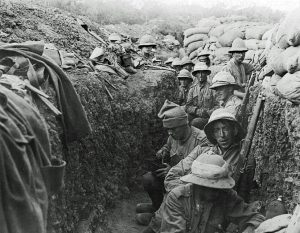 Sometimes, there were cave-ins of the trenches. If the soldiers caught in the cave-in were lucky, their fellow soldiers saw the cave-in, and quickly came to their fellow soldiers’ rescue. Sometimes, they could dig them out in time to save their lives. Unfortunately, all too often, they were too late. Worse yet, was the possibility that the battle was still raging, and while the soldiers knew of the peril their fellow soldiers were in, there was nothing they could do for them at that time, and when they could get too them, it was too late. Sometimes, no one was around to see the cave-in, and the bodies would not be found for months, or years, and sometimes never. Sometimes, these men would forever be listed as missing and presumed dead. And that was the worst fate of all.
Sometimes, there were cave-ins of the trenches. If the soldiers caught in the cave-in were lucky, their fellow soldiers saw the cave-in, and quickly came to their fellow soldiers’ rescue. Sometimes, they could dig them out in time to save their lives. Unfortunately, all too often, they were too late. Worse yet, was the possibility that the battle was still raging, and while the soldiers knew of the peril their fellow soldiers were in, there was nothing they could do for them at that time, and when they could get too them, it was too late. Sometimes, no one was around to see the cave-in, and the bodies would not be found for months, or years, and sometimes never. Sometimes, these men would forever be listed as missing and presumed dead. And that was the worst fate of all.
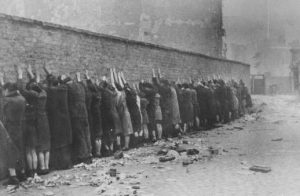 When the Nazis began their annihilation of of the Jewish people, many were caught completely unaware. I think it’s impossible to think that anyone could do such horrible things to other human beings. Many of the Jews actually went along with how things were going…at first. By the time they realized the predicament they were in, it was too late. Other Jews, somehow knew that moving into the “ghetto” was the beginning of their end. Some thought they would never leave their homeland, but would rather wait out the war, which would “be over before they knew it,” but it wasn’t over…not for a long time, and for some ended only in death. Many Jewish families wouldn’t survive the war, at least not intact. Over the years of the war, no Jews could say they didn’t know anyone who had died, because they all knew some who had died, and often it was their own family members.
When the Nazis began their annihilation of of the Jewish people, many were caught completely unaware. I think it’s impossible to think that anyone could do such horrible things to other human beings. Many of the Jews actually went along with how things were going…at first. By the time they realized the predicament they were in, it was too late. Other Jews, somehow knew that moving into the “ghetto” was the beginning of their end. Some thought they would never leave their homeland, but would rather wait out the war, which would “be over before they knew it,” but it wasn’t over…not for a long time, and for some ended only in death. Many Jewish families wouldn’t survive the war, at least not intact. Over the years of the war, no Jews could say they didn’t know anyone who had died, because they all knew some who had died, and often it was their own family members.
One such family, the Shwartz family managed over the years of the war to escape time after time to emerge intact…against all odds. The family had been hit by loss, of course, but not at the hands of the Nazis. At first their lives weren’t affected. They lived in the country, and the “ghettos” seemed so far away. Then it started. It began with the Russians, yes Russians…they had been there at first in an effort to hold back the Germans, but in this case, they weren’t much better than the Germans. At first they took the vegetables and livestock to feed the soldiers, then they took the home. So the family moved.
When the Germans invaded, the family moved to a different town, but before long they were expected to go to the “ghettos.” Instead, they made their escape from Poland to Romania. Before long the family had to be split up to protect themselves. They lived in barns and small sheds, but still they weren’t really safe. They finally had to put their children up for adoption to Christian families, but even that wasn’t safe later on, and the children ended up back with their own parents. Eventually, one of the children at all of ten years old, decided that he was going to Palestine. He went, but they thought he had died when the ship sank. In reality, he was on a different ship, because his ship had been overbooked.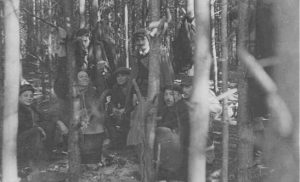
His aunt had also been with the family, and she had been able to move around under the radar, because of her blonde hair and blue eyes. She didn’t look Jewish. During one border crossing, the family was caught by German Gestapo, but the men were young and they were able to fool them into thinking they belonged. Of course, I am oversimplifying their entire ordeal, but miraculously, they entire family live through the Holocaust, without ending up in the camps, and in the end, they moved to Palestine, where they still live today.
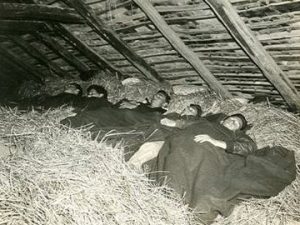 On January 24, 1944, the first of over 500 American airmen bailed out of their disabled planes over the German-occupied zone of Serbia. That first day, the Germans shot down two Liberators…one over Zlatibor and the other over Toplica. One bomber made an emergency landing between Plocnik and Beloljin. That crew of nine men were rescued by the Chetnik Toplica Corps under the command of Major Milan Stojanovic. The crew were placed in the home of local Chetnik leaders in the village of Velika Dragusa. The other bomber crew bailed out over Mount Zlatibor. They were found by members of the Zlatibor Corps. A radiogram message on the rescue of one of the crews was sent by Stojanovic to Mihailovic on January 25th. Major Stojanovic wrote that the previous day about 100 bombers flew from the direction of Nis towards Kosovska Mitrovica, and that they were followed by nine German fighter aircraft. After a half-hour battle, one plane caught fire and was forced to land between the villages of Plocnik and Beloljin, in the Toplica River valley.
On January 24, 1944, the first of over 500 American airmen bailed out of their disabled planes over the German-occupied zone of Serbia. That first day, the Germans shot down two Liberators…one over Zlatibor and the other over Toplica. One bomber made an emergency landing between Plocnik and Beloljin. That crew of nine men were rescued by the Chetnik Toplica Corps under the command of Major Milan Stojanovic. The crew were placed in the home of local Chetnik leaders in the village of Velika Dragusa. The other bomber crew bailed out over Mount Zlatibor. They were found by members of the Zlatibor Corps. A radiogram message on the rescue of one of the crews was sent by Stojanovic to Mihailovic on January 25th. Major Stojanovic wrote that the previous day about 100 bombers flew from the direction of Nis towards Kosovska Mitrovica, and that they were followed by nine German fighter aircraft. After a half-hour battle, one plane caught fire and was forced to land between the villages of Plocnik and Beloljin, in the Toplica River valley.
Over the next few months, more planes were shot down, and more crews were rescued by the Serbian resistance. In all it was thought that 432 men had been hidden, effectively saving them from the German prison camps. In the end, it was determined that the actual number of men in need of rescue was 512. The men had no way of knowing that they would be “guests” of the Serbian resistance for 7 long months, and in some cases longer.
The two resistance groups, Marshal Tito’s Partisans and Draza Mihailovic’s Chetniks, both hated the Nazis vehemently, and they also hated each other. It made working together difficult at best. Still, they shared a common goal…to defeat the Nazis, and they were willing to do what was necessary to achieve that goal. While it was sometimes possible to smuggle the airmen out and reunite them with their units, it was not always possible. When they could not get the men out, they kept them in their homes, and shared what little food they had with them.
In July 1944, these men again came to the attention of the Office of Strategic Services (OSS), and they began to draw up plans to bring the men home. I’m sure by then, the men thought they really had been forgotten, or maybe that no one knew about them at all, but now they were going to be going home. Operation Halyard, the operation to bring home these men, commenced on August 9, 1944 and continued until December 28, 1944. The men would be airlifted out of Serbia 12 men at a time, but before any airlift could take place, they had to build an airstrip. The C-47 cargo plane required 700 feet of runway for takeoffs and landings. The men and the 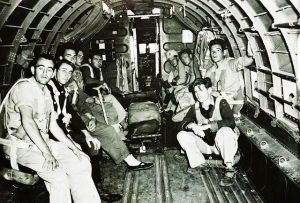 people of Serbia built an airstrip that was exactly 700 feet long. It was bordered by forest and mountains, so the takeoffs and landings would have to be precise. According to historian Professor Jozo Tomasevich, a report submitted to the OSS showed that 417 Allied airmen who had been downed over occupied Yugoslavia were rescued by Mihailovic’s Chetniks, and airlifted out by the Fifteenth Air Force. According to Lieutenant Commander Richard M Kelly (OSS), a grand total of 432 United States and 80 Allied personnel were airlifted during the Halyard Mission. In the end, at least in this mission, the military lived up to its motto, “Never leave a man behind.”
people of Serbia built an airstrip that was exactly 700 feet long. It was bordered by forest and mountains, so the takeoffs and landings would have to be precise. According to historian Professor Jozo Tomasevich, a report submitted to the OSS showed that 417 Allied airmen who had been downed over occupied Yugoslavia were rescued by Mihailovic’s Chetniks, and airlifted out by the Fifteenth Air Force. According to Lieutenant Commander Richard M Kelly (OSS), a grand total of 432 United States and 80 Allied personnel were airlifted during the Halyard Mission. In the end, at least in this mission, the military lived up to its motto, “Never leave a man behind.”
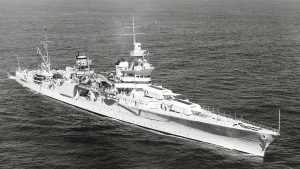 The USS Indianapolis (CL/CA-35) was a Portland-class heavy cruiser of the United States Navy, named for the city of Indianapolis, Indiana. The ship was launched in 1931, the vessel served as the flagship for the commander of Scouting Force 1 for eight years, then as flagship for Admiral Raymond Spruance in 1943 and 1944 while he commanded the Fifth Fleet in battles across the Central Pacific during World War II. Those were tumultuous times, and sometimes things “fell through the cracks,” but what happened to the USS Indianapolis was seriously unthinkable.
The USS Indianapolis (CL/CA-35) was a Portland-class heavy cruiser of the United States Navy, named for the city of Indianapolis, Indiana. The ship was launched in 1931, the vessel served as the flagship for the commander of Scouting Force 1 for eight years, then as flagship for Admiral Raymond Spruance in 1943 and 1944 while he commanded the Fifth Fleet in battles across the Central Pacific during World War II. Those were tumultuous times, and sometimes things “fell through the cracks,” but what happened to the USS Indianapolis was seriously unthinkable.
In July 1945, after the Indianapolis completed a top-secret high-speed trip to deliver parts of Little Boy, the first nuclear weapon ever used in combat, to the United States Army Air Force Base on the island of Tinian, they subsequently departed for Guam and then it was on to the Philippines on training duty. Little Boy was the bomb that was going to effectively end the war, but the war was not over yet, and it was imperative that everyone be on high alert. The waters in many areas of the world were filled with hidden dangers…namely, German U-Boats and Imperial Japanese Navy Submarines. Many a ship was sunk by these hidden enemies.
At 12:05am on July 30, 1945, the USS Indianapolis was torpedoed by the Imperial Japanese Navy submarine I-58, while en route to the Philippines. The mighty ship sank in just 12 minutes. There were 1,195 crewmen aboard, and approximately 300 went down with the ship, unable to get to the deck in time. The remaining 890 men were faced with exposure, dehydration, saltwater poisoning, and shark attacks while stranded in the open ocean with few lifeboats and almost no food or water. The scene was horrible. The men in the water could not necessarily see the sharks, but the screams of their fellow crewmen were unmistakable. And if the crew wasn’t dying by shark attack, they were slowly dying at the hands of the elements. Dehydration caused many to drink the saltwater that was in abundance around them, but soon it poisoned them, and instead of saving them, it killed them.
Because of the speed with which USS Indianapolis sank, there was no time to send a distress signal or even 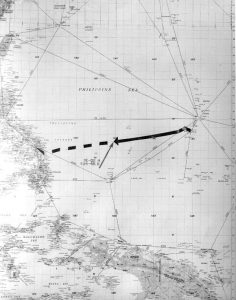 deploy all of the lifeboats and equipment. The men knew they would need to survive until their ship was overdue and reported missing. They didn’t know how long it would take, and this is where the Navy failed these men. Navy directive 10CL45, which meant no reporting of combatant ships that failed to arrive. No search until by accident someone saw an oil slick. When Indianapolis was overdue, the people who would have reported it as overdue, simply assumed that Indianapolis might have been redeployed to another training area, since that was part of their mission. According to the directive, no search crews were sent out. These men were unthinkably alone in the vast sea…and no help was coming. In fact, the Navy only learned of the sinking four days later, when survivors were spotted by the crew of a PV-1 Ventura on routine patrol. By the time the rescue began, only 316 of the 890 men who survived the original sinking were still alive. The sinking of Indianapolis and Navy directive 10CL45 resulted in the greatest single loss of life at sea from a single ship in the history of the US Navy.
deploy all of the lifeboats and equipment. The men knew they would need to survive until their ship was overdue and reported missing. They didn’t know how long it would take, and this is where the Navy failed these men. Navy directive 10CL45, which meant no reporting of combatant ships that failed to arrive. No search until by accident someone saw an oil slick. When Indianapolis was overdue, the people who would have reported it as overdue, simply assumed that Indianapolis might have been redeployed to another training area, since that was part of their mission. According to the directive, no search crews were sent out. These men were unthinkably alone in the vast sea…and no help was coming. In fact, the Navy only learned of the sinking four days later, when survivors were spotted by the crew of a PV-1 Ventura on routine patrol. By the time the rescue began, only 316 of the 890 men who survived the original sinking were still alive. The sinking of Indianapolis and Navy directive 10CL45 resulted in the greatest single loss of life at sea from a single ship in the history of the US Navy.
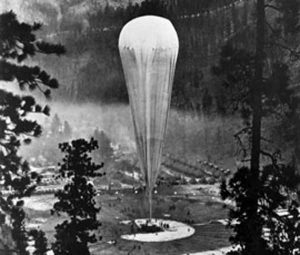
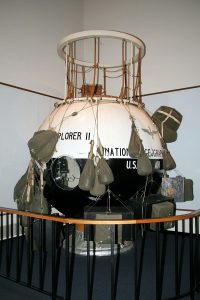 In the Black Hills of South Dakota, south-west of Rapid City lies a natural depression in the Earth. Apparently, the depression is a sinkhole that has 700 feet deep cliff walls all around, that prevent wind from reaching the bottom. The windless part of the site is what makes it perfect for balloon launches. The site was noticed by the National Geographic Society and the United States Army Air Corps, who set up what they called Stratocamp in 1934-1935. Stratocamp was a joint effort code named Explorer to launch two manned giant helium high-altitude balloons capable of stratospheric flight. The crash of the Soviet Osoaviakhim-1 after setting a world record flight of 72,178 feet (13.71 miles), the Explorer program set a new goal…to beat that record. The first Explorer balloon was launched on July 28, 1934. The balloon made it 11 miles up before it disintegrated. Thankfully the astronauts onboard had parachutes on, so they survived.
In the Black Hills of South Dakota, south-west of Rapid City lies a natural depression in the Earth. Apparently, the depression is a sinkhole that has 700 feet deep cliff walls all around, that prevent wind from reaching the bottom. The windless part of the site is what makes it perfect for balloon launches. The site was noticed by the National Geographic Society and the United States Army Air Corps, who set up what they called Stratocamp in 1934-1935. Stratocamp was a joint effort code named Explorer to launch two manned giant helium high-altitude balloons capable of stratospheric flight. The crash of the Soviet Osoaviakhim-1 after setting a world record flight of 72,178 feet (13.71 miles), the Explorer program set a new goal…to beat that record. The first Explorer balloon was launched on July 28, 1934. The balloon made it 11 miles up before it disintegrated. Thankfully the astronauts onboard had parachutes on, so they survived.
The second balloon was launched in November 11, 1935, and ascended 14 miles up, before landing near White Lake, South Dakota. They had done it. That second flight set a world record that would not be broken until astronauts started flying into space. Astronauts, Air Corps Captain Albert William Stevens, Captain Arson Anderson, and Major William E. Kepner became the first men to view the Earth’s curvature. This exploration helped the Air Force build better planes and helped scientists build satellites.
In the 1950s, Project Manhigh and Project Strato-Lab launches were made from a man-made crater of an iron mining pit near Crosby, Minnesota, and if weather allowed, from Fleming Field in South Saint Paul, Minnesota. The Stratobowl was used as a backup location, if launches could not be made at the Minnesota locations. As it turned out, the Stratobowl was needed for a number of launches. The first such launch was on November 8, 1956, when the Strato-Lab I gondola lifted Malcolm Ross and M L Lewis from the Stratobowl to a world altitude record for manned balloon flight of 76,000 feet. There were also three Stratobowl launches in 1958, and seven in 1959. The most publicized flight was that of Strato-Lab IV, piloted by Malcolm Ross and Charles B Moore, which lifted off from Stratobowl on November 28, 1959. The balloon reached an altitude of 81,000 feet, and landed safely in Kansas after 20 hours in the air. The purpose of the flight was to perform spectrographic analysis of the planet Venus with minimal interference from the Earth’s atmosphere.
These days, the Stratobowl is usually seen from a popular hiking trail that takes you up to the rim…which is 
 how my husband, Bob and I first saw it. You can also drive down to the bottom, and there are festivals during which balloons are launched…to go to normal heights and to take tourists and owners for a normal ride. No records are set to be won, or experiments to be made. Still, looking at the Stratobowl from the top of the trail is very impressive, and while it is not a difficult or a long hike, we enjoyed it very much, and it is a short hike that I very much recommend. It was really interesting, and to think it is a sinkhole.
how my husband, Bob and I first saw it. You can also drive down to the bottom, and there are festivals during which balloons are launched…to go to normal heights and to take tourists and owners for a normal ride. No records are set to be won, or experiments to be made. Still, looking at the Stratobowl from the top of the trail is very impressive, and while it is not a difficult or a long hike, we enjoyed it very much, and it is a short hike that I very much recommend. It was really interesting, and to think it is a sinkhole.
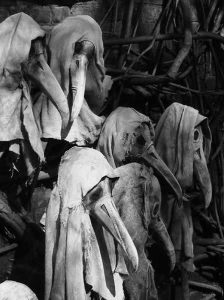
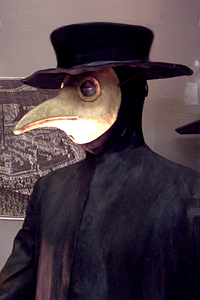 Imagine, waking up from a feverish delirium, to find yourself staring into the face of a doctor who looked like some type of bird, and a scary one at that. When people are delirious and feverish, they are already not in their right mind, so looking at the man, who looked like a giant hawk, could be…well, frightening. The poor sick patient, might have believed that they had been abducted by aliens.
Imagine, waking up from a feverish delirium, to find yourself staring into the face of a doctor who looked like some type of bird, and a scary one at that. When people are delirious and feverish, they are already not in their right mind, so looking at the man, who looked like a giant hawk, could be…well, frightening. The poor sick patient, might have believed that they had been abducted by aliens.
Medicine has come a long way over the centuries. Long ago, physicians in Europe thought that diseases were caused by “bad air.” Scientists like Louis Pasteur, Robert Koch, and Joseph Lister hadn’t yet come up with the scientific proof of the germ theory of disease. Sometimes, it just makes you wonder how anyone managed to survive in those days. Still, the doctors did know that somehow they needed to protect themselves, be it from the “bad air” or germs that they didn’t even know existed. I guess they figured that “when in doubt…protect yourself” first. It was good advise then and good advise now. A healthcare worker, be it doctor, nurse, cna, or caregiver, cannot be of any use to their patient, if they get sick too.
So, to safeguard themselves against miasma, which was the name they gave to this “bad air” and since the doctors then didn’t know about the kinds of gear that is available these days, the doctors donned a curious accessory while treating sickly patients…a mask with a long, bird-like beak, which was stuffed with dried flowers, herbs, and spices. The gear was used during the Carnival of Venice, so some people might recognize it as the “plague doctor” costumes, but they probably wouldn’t know that, with the costumes were an exaggeration, this type of gear was really used during plagues in the 17th century.
It is thought that doctors accepted this type of mask, thanks in part to the Black Death, which ravaged the Middle East, Asia, and Europe during the 14th century, but medical historians say it wasn’t invented until three 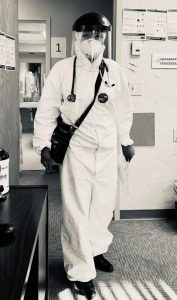 centuries later, when a 16th century French doctor named Charles de Lorme likely designed what could be described as one of history’s earliest hazmat suits during later waves of the plague, and it was very similar to these. I’m sure they did the best they could, but my guess is that is was sorely inadequate. The de Lorme suit consisted of “a full head-to-toe protective garment, modeled after a soldier’s canvas gown which went from the neck to the ankle. The over-clothing garment, as well as leggings, gloves, boots, and a hat, were made of waxed leather. The garment was impregnated with similar fragrant items as the beak mask.”
centuries later, when a 16th century French doctor named Charles de Lorme likely designed what could be described as one of history’s earliest hazmat suits during later waves of the plague, and it was very similar to these. I’m sure they did the best they could, but my guess is that is was sorely inadequate. The de Lorme suit consisted of “a full head-to-toe protective garment, modeled after a soldier’s canvas gown which went from the neck to the ankle. The over-clothing garment, as well as leggings, gloves, boots, and a hat, were made of waxed leather. The garment was impregnated with similar fragrant items as the beak mask.”
These days, our healthcare workers, who are working with serious diseases, such as Covid-19, wear gear that is much more capable of protecting them. Healthcare workers like my friend, Nurse Practitioner, Angela Booth might look like they are wearing…well, almost bunkers, like a firefighter wears, with the exception of the heavy oxygen, of course. Still, the gear they are wearing is highly sophisticated and is much better able to protect them from the disease, than gear used to be, and anyone who has friends or family in the healthcare industry, can be thankful for that. For patients, it might still be scary to see the doctor or nurse dressed that way.
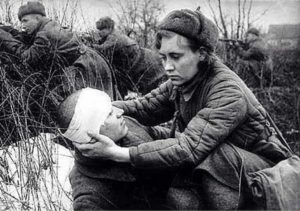 When Natalia Peshkova was a girl in high school, during the early years of World War II, women were not allowed to join the Russian Army. Nevertheless, the women of Russia wanted to help, just like women from most of the Allied nations. As the war went on, the need for soldiers brought women into the draft…like it or not. Peshkova found herself recruited right out of high school, and at the age of 17, she was set to be a combat medic.
When Natalia Peshkova was a girl in high school, during the early years of World War II, women were not allowed to join the Russian Army. Nevertheless, the women of Russia wanted to help, just like women from most of the Allied nations. As the war went on, the need for soldiers brought women into the draft…like it or not. Peshkova found herself recruited right out of high school, and at the age of 17, she was set to be a combat medic.
Things were tough in the arena Peshkova found herself in. The poorly equipped unit was faced with weapons that continuously malfunctioned…not a good thing to defend yourself with. Peshkova’s stint in the Russian army was filled with constant disease, starvation, and even the loss of a boot to a hungry horse, while she slept. To say the least, life in the Russian army was tough.
Despite the hardships, Peshkova did her duty as a combat medic, protecting and helping soldiers that were wounded on the front lines as much as she could. Her training taught her to protect wounded soldiers from the front and get them safely to hospitals, often placing herself in possible harm’s way. While she was trained to apply first aid, her main duty was always to remove wounded men from the front line. Trying to do first aid on the front lines was a dangerous maneuver for both soldier and medic. Peshkova was wounded three times for her efforts, but she had a kind of strength and determination that was unmatched in the field, and she always returned to the front when she had healed. I’m sure many people thought she was half crazy.
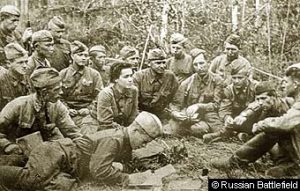
At one point, Peshkova got separated from her unit, finding herself behind enemy lines when the Germans took over territory previously held by the Russians. She had to act fast, so she disguised herself, while also hiding her weapon, because if she discarded it, she would have been executed by her own military. She finally made it back to her unit and survived three years on the front lines. She rose through the ranks to become Sergeant Major, and was then given political education duties that finally relived her from life on the front lines. Natalia Peshkova was truly one of a kind, and was awarded the Order of the Red Star for Bravery.
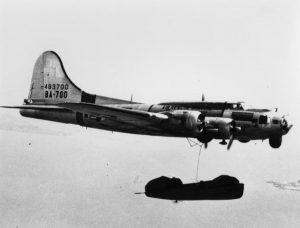 Built in Seattle, Washington by Boeing, the B-17G, which was later converted to a B-17H for use as an emergency air-sea rescue plane. It was equipped with a Higgins A-1 lifeboat attached to the lower fuselage. The plane and crew including Pilot, 1st Lieutenant William C Motsinger; Co-Pilot, 2nd Lieutenant Robert W Ball; Crew, 1st Lieutenant Rollin C Marsh; Engineer, Captain Norman E Zahrt; Navigator, Technical Sergeant Robert W Conger; Gunner, Staff Sergeant Gerard J Doody; Crew, Staff Sergeant Charles J Parkins; Crew, Sergeant Charles Edward Hurn; Crew, Sergeant Elliott Leroy Griffin; and Crew, Sergeant Otis E Anderson Jr; was assigned to the 20th Air Force, 4th Emergency Rescue Squadron. The plane was given no known name or nose art, which happened more than people knew, but it had a Radio Call Sign of “Jukebox 21.”
Built in Seattle, Washington by Boeing, the B-17G, which was later converted to a B-17H for use as an emergency air-sea rescue plane. It was equipped with a Higgins A-1 lifeboat attached to the lower fuselage. The plane and crew including Pilot, 1st Lieutenant William C Motsinger; Co-Pilot, 2nd Lieutenant Robert W Ball; Crew, 1st Lieutenant Rollin C Marsh; Engineer, Captain Norman E Zahrt; Navigator, Technical Sergeant Robert W Conger; Gunner, Staff Sergeant Gerard J Doody; Crew, Staff Sergeant Charles J Parkins; Crew, Sergeant Charles Edward Hurn; Crew, Sergeant Elliott Leroy Griffin; and Crew, Sergeant Otis E Anderson Jr; was assigned to the 20th Air Force, 4th Emergency Rescue Squadron. The plane was given no known name or nose art, which happened more than people knew, but it had a Radio Call Sign of “Jukebox 21.”
B-17H Flying Fortress Serial Number 43-38882, aka Jukebox 21, took off from Motoyama Number 1 Airfield on Iwo Jima, on July 25, 1945, on a night search mission for F4U Corsair 81319 that crashed the day before near Arai at roughly over Lat 34° 35′ N, Long 137° 35′ E on the southern coast of Honshu, Japan. The weather was good, and yet Jukebox 21 was lost, without making a distress signal. That fact made the circumstances of the crash hard to figure, and only known when the B-17 failed to return. The crew was officially listed as Missing In Action, and later as killed in action.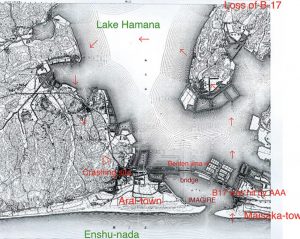
The B-17 flew over Maisaka near the Benten Jima bridge, flying northward at an altitude of roughly 984 feet. Crossing the coast, 75mm anti-aircraft guns on the south side of the highway at Benten Jima opened fire on the bomber. Jukebox 21 was hit by anti-aircraft fire, one of the engines began smoking as the plane flew northward, then attempted to circle to the west over Lake Hamana, then southward. Trailing black smoke, one of the engines on the right wing broke off before the bomber crashed at Yakute to the northwest of Arai. Jukebox 21 impacted pine trees before crashing into the ground nose first at Yakute, to the northwest of Arai. Immediately after the crash, Japanese civilians ran to the crash site and observed several mounds of debris and fire and observed the rescue boat in the wreckage. There were no survivors. Thirty minutes after the crash, Japanese Keibodan (wartime guards) reached the crash site and extinguished the fire. The bodies of the ten crew were recovered, all badly burned from the fire and no identification was possible. Afterwards, the bodies of the crew were cremated and buried at the nearby Arai crematorium, along with the body of the Corsair pilot that crashed the previous day.

Twelve Allied aircraft participated in a search over two days under the direction of Major Ivan K Mays. No wreckage was located, and all stations and ships were told to be on the lookout for this bomber. On May 22, 1947 US Army investigators visited Arai to investigate the possibilities of any atrocities in connection with the death of this crew, but found none. During their visit, they interrogated Katsumi Kumagai the former Kempei Tai commander for Arai who explained how the B-17 crashed and how the crew’s bodies were recovered, cremated, and buried. Afterwards, the remains of the crew were recovered and transported to the United States for permanent burial. Somewhat strangely, the Japanese placed a memorial to the men of Jukebox 21 at the Jingu-ji Temple in Kosai, Japan.

